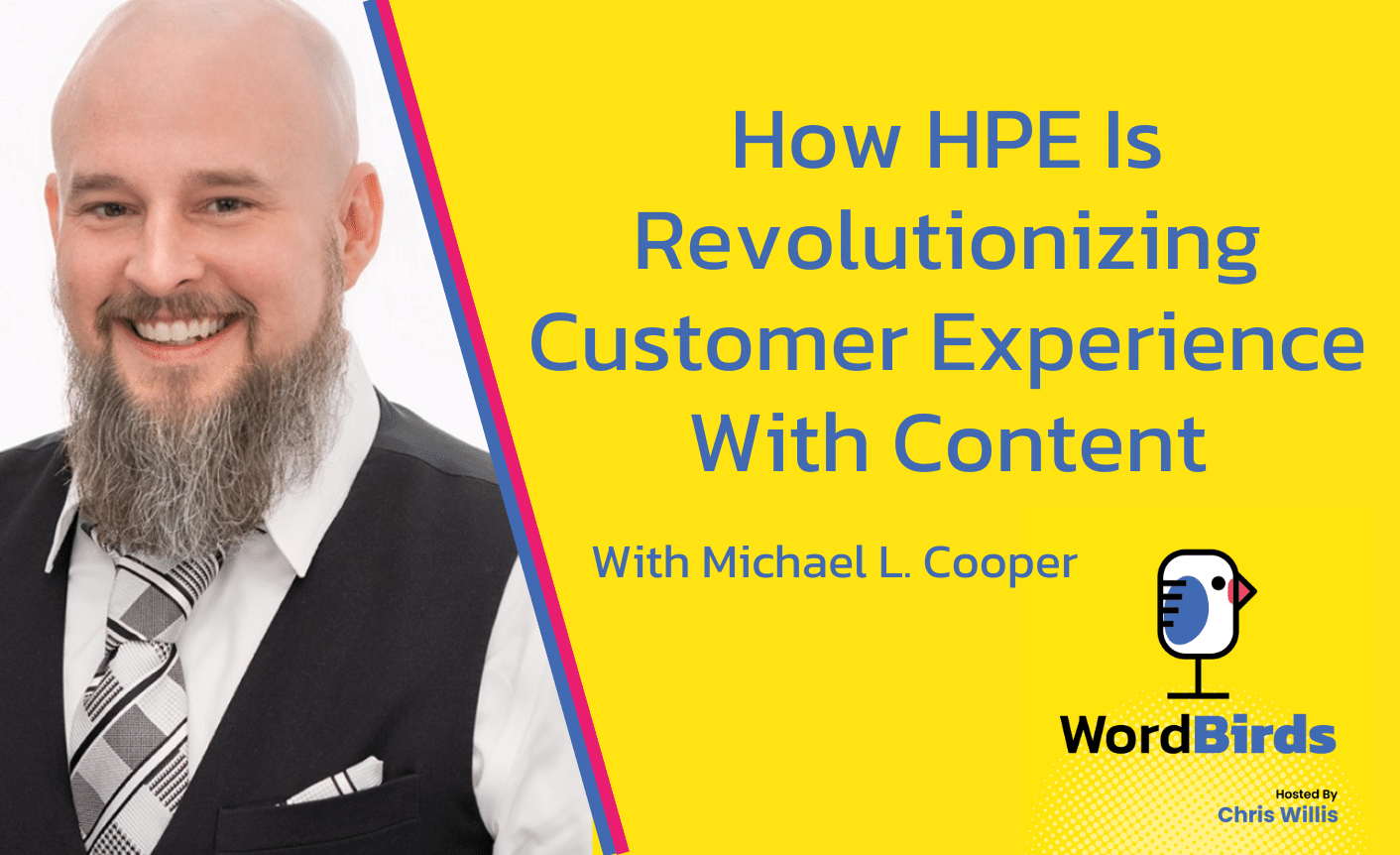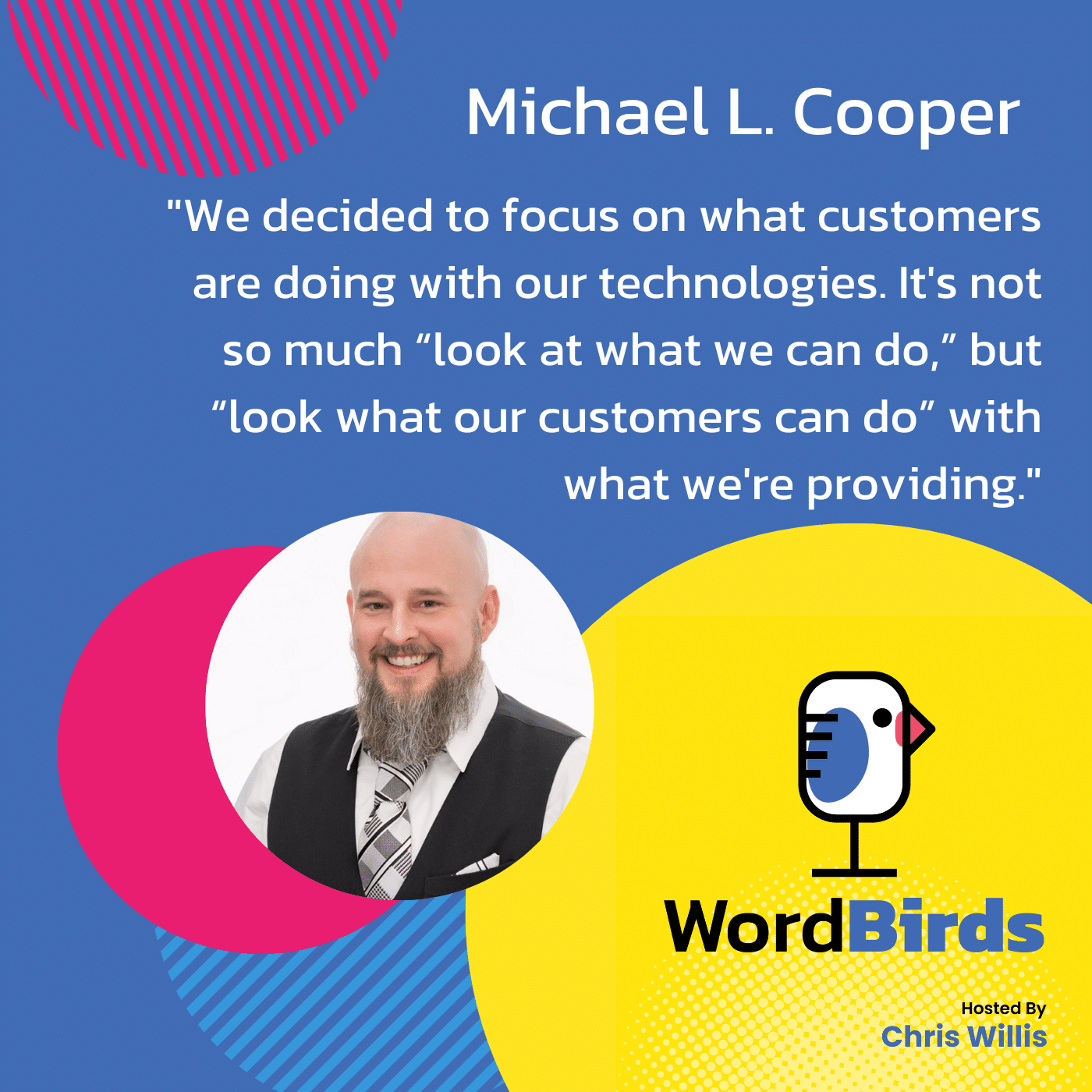
Hewlett Packard Enterprise (HPE) is changing the customer experience game with their Customer Innovation Centers.
Fancy exploring the International Space Station (ISS) or working in the pit lane during a Formula One (F1) race? Anything is possible with HPE’s virtual reality (VR) experiences for their customers. HPE understands that the best way to show their product capabilities is to let their customers experience them in action.
For this week’s episode, we chatted with Content Experiences Manager for HPE Customer Innovation Centers, Michael L. Cooper. You’ll hear about the content that fuels HPE’s Customer Innovation Centers and how HPE is revolutionizing customer experience. This is a fun episode that you don’t want to miss.
Tune in below to take your content to the next level and use it to drive amazing experiences.
Watch the episode
Listen to the episode
Read full episode transcript
Hello Michael and welcome to WordBirds!
Thank you! It’s a pleasure to be here. I’m super excited to be on the show and talk to you about some of the awesome stuff that we’ve been doing here at HPE.
I’m also excited about that. Like we start just about every episode now, we’re at the quick fire section. I’m going to say a thing and all I need is just a quick answer from you. Once we finish, we’ll key in on anything super interesting that happened.
Amazing content is …
Oh, the first rung! There’s so much more that you have to do now other than create amazing content. I wish it was just as easy as creating amazing content, but it’s just the beginning.
Concise or descriptive content?
Let’s get to the point please! Let’s be concise.
There are way too many word jumbles that exist out there. If we can just get to the point I think everyone, internally and customers, everyone would appreciate it. So let’s be concise.
The company with the best brand voice is?
I’m going to reveal myself as a sneakerhead, but I’m going to say Nike. I love Nike! I’m on their sneakers app, on the Nike app. I remember having my first Air Jordan’s when I was a kid. You want to talk about longevity, you don’t even have to have their name anymore just the swoosh and you know who they are.
Best piece of content advice?
Oh that’s a tough one. Know your audience, for sure. Especially post pandemic, if you don’t know your audience then you’re wasting your time.
And finally when I’m creating content I always …
Put myself in the perspective of who I believe will be consuming this content.
So the last two tie together and I think it’s really interesting because we get that answer quite a bit.
I think all of us as content people have shifted to a world of really focusing on the audience. And I think it’s interesting because when you think about the way that you build, for instance, your style guide or your tone of voice inside of business, it’s a thing that we create. That’s our job, but the idea of matching that to the audience and then monitoring the audience to see how they accept and engage brings all of that into focus as a thing that evolves.
Yeah and for me working at a technology company it’s all about the data that’s tied to all of that too, right? Constantly monitoring to see what people are consuming, how long they’re consuming it, and what works for them — even on our interactive storyboards that we have here in our center.
It's not so much “look at what we can do,” but “look what our customers can do” with what we're providing. Share on XBeing able to see what people are spending time consuming and using that data is really what’s going to help us propel things to the next level. To get the content out that people aren’t consuming or if they’re not spending as much time on it and determining why using the data. Determine what it is about this piece of content that makes it less desirable to consume and how can we improve that.
Oh fantastic answer! On that note, let’s talk about what you do here. Tell me about the concept of the HPE Customer Innovation Center.
Sure, HPE just recently changed headquarters location. We were previously in San Jose, California and we decided about two years ago that we were going to relocate to Texas. So we’re now located on the north side of Houston, Texas. And a part of this new building — this was a ground up build — gave us an opportunity to look at how we wanted to approach several things. And one of those was how we’re going to use our Executive Briefing Center.
How we had done this in the past was so traditional and we decided that as we have this opportunity to start fresh and really to take a look and use the data to determine what this needed to be moving forward. We decided that the focus on what the customer was doing with the technologies that we’re bringing forward is what’s of most importance. It’s not so much “look at what we can do,” but “look what our customers can do” with what we’re providing.
You’ve talked about an Executive Briefing Center, I’ve heard of an Executive Briefing Center. The idea of a Customer Innovation Center is very specific. Was that a decision that was made and why is it important to be known as a Customer Innovation Center versus just the standard Executive Briefing Center?
So the standard Executive Briefing Center really implies c-suite only, so your CEOs, your CFOs, your CIOs coming in and that’s not what we’re after. We’re looking to expand who we’re opening this space.
As part of that we decided the executive side didn’t really fit anymore and that the “executive briefing” sounds more like a one-way conversation and again that’s not what we’re doing here now. We’re having a conversation together to help determine what we can do as a team to propel and move things forward for our customers.
And that leads towards the way that you communicate because you’ve been very specific about terminology in this case. How do you maintain that consistency of message and journey across multiple centers across the globe?
So that was challenging because we really are spread out. We have seven global centers, one obviously being in Houston, one in San Jose, New York city, then across the other side of the pond we have London, Geneva, Dubai, and Singapore — we’re in almost all of the time zones!
Making sure the messaging is consistent was difficult, honestly, because we also didn’t want to diminish the local flare. Like those stories that really made that center shine or those showcases that they had because every center definitely has a unique flavor to it.
But you still have to have consistency of message and so we ended up going with a platform that allows us to push content to screen. So I can see across all seven of our centers, at any given time, from anywhere that I am, what content is being shown in each of those locations and creating playlists for each of those centers.
Determine what it is about this piece of content that makes it less desirable to consume and how can we improve that. Share on XThe great thing is that we can create these playlists in a way that has all of the consistent messaging we want in all of our centers. But it also allows those centers to individually go in and add specific content that adds to the local flare of that particular location.
The ability to manage the content in that way is so impactful because as we work with the brand team, as new things come out, being able to add new content is great. But it’s also important that you don’t have dated, stagnant content that’s been out there for too long or that’s no longer relevant. Being able to deactivate that from one place in a global fashion just makes such a massive impact on how we make sure that our message is consistent across the globe.
I like that hierarchical rule model. So at the top there are things that everybody, all the centers, are going to do. Then you drill down into each one of them and there’s variation — as long as they maintain, for instance, to use the name of the company correctly.
From there down one center in New York, different from one center in Houston, has their own language. You got a New York accent, maybe a Long Island accent in Manhattan and a lot of “y’all”s being used in Houston.
I did say Houston, you know we do it!
I’m being way too specific, but it’s right in there bringing that local flare but adopting the guidelines of the business down into those segments.
In addition to us making that shift from Executive Briefing Center to Customer Innovation Center, we had some internal branding there that we had to get used to. But then outward facing, we have to make sure there’s some clarification there that HP — that makes the laptops, desktops, and printers — is a separate company from who we are as Hewlett Packard Enterprise.
Currently aboard the ISS right now, orbiting around our heads, is a piece of Hewlett Packard Enterprise hardware called the “Spaceborne Computer Two.” Share on XWe’re more enterprise facing for our customers and so we’re looking at edge to cloud whereas they’re looking at desktop to print. So making sure that all of those messages and names are consistent across the board and that that’s clear to our customers when they come in. They know who we are, they know we’re about because of this system that we’ve implemented where we’re able to do that.
When we talk about content I think people generally think “okay written words,” but that’s not all for you right now. You’re also using VR to help customers understand how they can work with you and how your products work. Tell me a little bit about how VR as a piece of content is helping you do your job.
So you like for customers to be able to use their imagination, just like if you’re going to go buy a new house. You want to picture yourself in that house before you’ve bought it, before you’ve signed the documents. You have to think about the layout and how it might look. We find that VR is a great way to do that kind of thing.
We have a few specific customer stories that we have created in VR that gives our customers that are coming into the centers the ability to experience those virtually. We were really particular about which stories that we told in that way because there are some stories that work perfectly fine as a white paper, or on our interactive storyboards, maybe in a video in our theater. There are certain stories that work just fine there. But there are a few stories where video and verbal or written just doesn’t do it justice, right?
One of those, of the three stories, is getting to go aboard the international space station. I think they called it “cost prohibitive” to try to send customers up on the ISS.
Depends on the customer!
Right! So we decided that was a great example of being able to show customers that currently aboard the ISS right now, orbiting around our heads, is a piece of Hewlett Packard Enterprise hardware called the “Spaceborne Computer Two.”
It’s half way through a thirty-six-month mission and it’s doing all these wild experiments. So, as part of this experience you get to go aboard the ISS, you get to do a space walk, and you get to change out a piece of hardware on the outside of the ISS. And all this was based on actual things that happened after we installed the Spaceborne Computer Two aboard the ISS. You get to actually experience what that would be like. And that’s just one of them.

We’re constantly talking about this edge to cloud story, well space is literally the edge of the edge, right? Because in that circumstance the cloud is actually Earth because it’s transmitting that data back down. But that gives customers an understanding of the rigor that all this hardware has gone through. It’s good out in space, surely it will be perfectly fine in your data center.
So being able to, again, picture yourself in that house before you purchased it’s what we’re after and we find that VR is a really great way to do that.
All I can think of is, I’ve done customer case study videos where they’re like you got to fly to Omaha and record this video. Some content creator inside HPE got a call one day saying “Hey, you got to go shoot a video.” “Really? Cool. Where?” “Space!” That’s fantastic!
The idea of immersive experiences in the technology space is dramatically underused. But you’re right, that draws somebody into it! You can show a bunch of pictures, like here’s an example of what’s happening, here’s a one-pager, it’s nice and glossy. But taking somebody into that experience changes your customer’s experience and makes it very real to them.
I think that’s incredibly innovative in what I see as a customer journey, which is generally digital content. This is ”Hey, we’re going to space today and we’re going to show you how this really works” and I think that’s incredibly powerful!
Just to add to that, in our customer centers you can come in and do that VR experience but the great thing about it’s that we also have other assets that are in the tour that we can go through that’s more hands-on. So it’s not just you experience this in VR.
One of the other experiences that we have in VR is being able to be in the pit along with the Mercedes AMG Petronas team and you’re making real time decisions based on the data that’s coming in as the F1 race occurs. Well, the great thing about this is that when you first walk into our center in Houston there’s a full scale authorized, licensed Mercedes AMG Petronas F1 race car. So before you experience this you get to see what the actual car looks like. Then you come around the back of the ramp and you can do the VR. Then you’re in the pit. So you’ve just heard all of this amazing stuff about what this car can do as an edge device and then you get to go experience it in VR immediately after that.
It’s the same thing with the space example. We actually have an astronaut suit and a replica of the Spaceborne Computer Two in our center. So again, one of the things that I’ve tried to focus on as we’re building these different content experiences is that it’s not just a “one-and-done,” right?
We want to make sure that when we hit on something that it sticks. And the best way to do that is to allow people to experience those stories in different ways because not everybody remembers things the same way. So the more times and the more different ways you can really build on that experience, the more impactful and the longer it stays in their memory.
Just so our listeners understand, how much cloud do I need to buy to be able to come to Houston?
We give tours all the time for people that want to check out the center. Obviously there would probably need to be some interest in our hardware and services. But yeah, we give a lot of tours! You can actually see, especially on social media, we get tagged all the time of people taking pictures with the race car and the astronaut suit. And our theater is something else! It’s a 180-degree LED screen that’s 50 feet wide, so it’s a lot!
It’s kind of the same here in our Concord office. People that come to visit here get to experience a 12-year old small dog that sits on my desk and sleeps. In reality it’s not as exciting, but that’s a thing that happens.
I think any other question that I ask on this is probably at this point redundant. Because the idea of how this is helping you achieve your goals, I see how it helps achieve your goals. It makes it real to people. It’s not just a thing like “Here’s an idea of a thing that we might be able to do.” It’s “Here’s a thing, we’ve done it. Please take part in it.” And that changes the game because it takes you beyond the paper. We think of content as the written word, this is real. This is living it.
It’s funny because in this post pandemic thing that we’re still dealing with, we integrate with a lot of our competitors now. So competition is a very different thing from what it used to be. Gosh, this reminds me of when I was a kid and the pastor in church would tell us our biggest competitor isn’t the church down the street, it’s the bed. Because just getting people out of bed to come to church on Sunday is what we’re after.
We want to make sure that when we hit on something that it sticks. And the best way to do that is to allow people to experience those stories in different ways. Share on XThat’s how it is now because people spent the last two or three years in this comfortable recliner, in front of a huge screen TV, and wearing comfortable clothing. Now getting people into the centers, I feel like the things that we’ve done seem like they’re really over the top, but that’s what you have to do now to get someone to physically come in and have this kind of conversation. Our competition is the same as everyone else’s. It’s that big screen TV that you bought over the past two years and that comfy chair that we can’t get you out of.
Seems like a really neat idea when you book tickets to go some place. And then it comes and you’re like “I don’t really want to go anymore.” But this would actually get people to leave and travel.
Here we are at my favorite part of the conversation. I like provocative and we’ve come up with this concept of the “provocative statement of the day.” What do you got? What are you seeing right now that isn’t a widely held position, that’s a little provocative?
Again, what I just finished with. Nobody wants to get out. Just getting people to a location now because everybody feels like they can do it remotely. I still think that there’s a massive impact on humanity, being able to have the conversation, and having the hands-on experiences.
So the provocative statement is that they don’t want to. Nobody wants to go do that anymore, nobody wants to travel, nobody wants to fly, nobody wants to go across the country to some company. People just want to see it online.
Getting them into this place, because this is where we can really build some excitement so we can show them what we’re doing. Then we can talk to them and understand what they’re doing. But what we’re really trying to do is figure out how we can work together to improve the way they do business in the future. Them being in the centers is just the best way. And you don’t get complaints when they’re leaving, right? It’s just getting them here in the first place.
It’s amazing because your provocative statement is actually your guiding force. This is the thing that you’re doing to drive engagement with your audiences, which I guess when you started it could have been a huge gamble. But I’m in! I’m ready to buy some cloud at this point, this is exciting.
For sure! The nice thing about it too is that we have this huge offering now that’s really all encompassing. That’s the “everything-as-a-service,” which a few companies have gone towards. But, again, that integration with what in the past has seemed like some competitors, this is a really great way for people to be able to have some hands-on experience.
We actually have some racks of hardware in our customer centers and it’s funny hearing customer feedback. It’s like “Now that we’ve moved to HPE Green Lake and everything is “as-a-service” it’s interesting to see the hardware that we don’t actually have in our physical location anymore because it’s all cloud based now.”
Exactly! Fantastic. Michael, thank you for being here. I think this is a remarkable use of content to drive customer engagement. Super excited about what you’re doing and hope to be able to talk to you again in the future. Thanks very much for being on the show!
Thank you very much, such a pleasure!
Important links
- Michael L. Cooper – LinkedIn
- HPE
- WordBirds – LinkedIn
- WordBirds – Home page
About Michael L. Cooper
Michael Cooper is a marketing experience sorcerer, conjuring up fantastical means of bringing new light to experiential storytelling. From virtual reality to immersive theaters, Michael brings his 20+ years of experience in the tech industry to lift the curtain on the ever-growing possibilities of next-gen content delivery. In his current role as a Content Experiences Manager for Hewlett Packard Enterprise, Michael leads the content programming across the seven global HPE Customer Innovation Centers.

Are you ready to create more content faster?
Schedule a demo to see how content governance and AI guardrails will drastically improve content quality, compliance, and efficiency.

Charlotte Baxter-Read
is a Communications and Content Manager at Acrolinx, bringing over three years of experience in content creation, strategic communications, and public relations. Additionally, Charlotte is the Executive Producer of the WordBirds podcast — sponsored by Acrolinx. She holds a Master’s degree from the John F. Kennedy Institute, at Freie Universität Berlin, and a Bachelor's degree from Royal Holloway, University of London. Charlotte, along with the Acrolinx Marketing Team, won a Silver Stevie Award at the 18th Annual International Business Awards® for Marketing Department of the Year. She's a passionate reader, communicator, and avid traveler in her free time.




